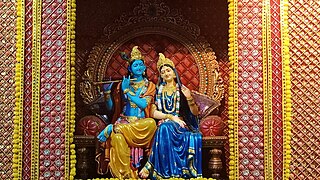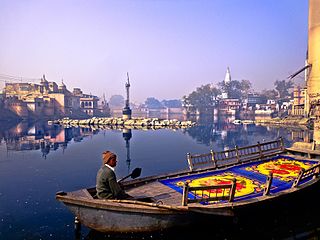
Mathura is a city and the administrative headquarters of Mathura district in the Indian state of Uttar Pradesh. It is located 57.6 kilometres (35.8 mi) north of Agra, and 146 kilometres (91 mi) south-east of Delhi; about 14.5 kilometres (9.0 mi) from the town of Vrindavan, and 22 kilometres (14 mi) from Govardhan. In ancient times, Mathura was an economic hub, located at the junction of important caravan routes. The 2011 Census of India estimated the population of Mathura at 441,894.

Braj, also known as Vraj, Vraja, Brij or Brijbhumi, is a region in India on both sides of the Yamuna river with its centre at Mathura-Vrindavan in Uttar Pradesh state encompassing the area which also includes Palwal, Ballabhgarh and Nuh in Haryana state, Deeg, Bharatpur, Karauli, and Dholpur in Rajasthan state and Morena District in Madhya Pradesh. Within Uttar Pradesh, it is very well demarcated culturally, the area stretches from the Mathura, Aligarh, Agra, Hathras and districts up to the Etah district. Braj region is associated with Radha and Krishna who according to scriptures were born in Barsana and Mathura respectively. It is the main centre of Krishna circuit of Hindu pilgrimage.

Vrindavan, also spelt Vrindaban and Brindaban, is a historical city in the Mathura district of Uttar Pradesh, India. It is located in the Braj Bhoomi region and holds religious importance for Hindus who believe that Krishna, one of the main Gods in Hinduism, spent most of his childhood in this city. Vrindavan has about 5,500 temples dedicated to the worship of Krishna and his chief consort, Radha. It is one of the most sacred places for Vaishnava traditions.

Mathura district is situated along the banks of the river Yamuna is a district of Uttar Pradesh state of north-central India. The historic city of Mathura is the district headquarters. Mathura district is home to many important sites associated with goddess Radha and Lord Krishna, who was born in Mathura and grew up in the nearby town of Vrindavan. Both cities are some of the most sacred sites in the Vaishnava tradition, making Mathura district an important Hindu pilgrimage centre.
Prabhas Patan, historically named Dev Patan, is a locality in Veraval, Gujarat. As the site of the Somnath temple and its associated Jyotirlinga, it is an important place of Hindu pilgrimage.
Chaumuhan is a town and a nagar panchayat in the Mathura district of the Indian state of Uttar Pradesh.
Jewar is a town and a nagar panchayat in Gautam Buddha Nagar district in the Indian state of Uttar Pradesh. Noida, Dadri and Jewar are the 3 sub-divisions of GB Nagar district, each headed by a SDM.
Sirsaganj is a town and a municipal board in Firozabad district in the Indian state of Uttar Pradesh.
Nandgaon is a historical town and a nagar panchayat in Mathura district in the Indian state of Uttar Pradesh. Nandgaon is a religious centre in Braj region.

In Hinduism, the yatra (pilgrimage) to the tirthas has special significance for earning the punya needed to attain the moksha (salvation) by performing the darśana, the parikrama (circumambulation), the yajna, the Dhyana, the puja (worship), the prarthana, the dakshina, the seva, the bhandara, etc. These sacred places are usually located on the banks of sacred waters, such as sacred rivers or their tributaries, the kundas, the ghats, or the stepwells, or the temple tanks.

Situated in the northern part of India, bordering with the capital of India New Delhi, Uttar Pradesh is one of the most popular and an established tourist destination for both Indians and non-Indians alike in India. The most populous state of India, Uttar Pradesh contains many historical monuments and places of religious significance. Geographically, Uttar Pradesh is very diverse, with Himalayan foothills in the extreme north and the Gangetic Plain in the centre. It is also home of India's most visited sites, Hinduism's holiest city, Varanasi. Kumbh city, Prayagraj. Kathak, one of the eight forms of Indian classical dances, originated from Uttar Pradesh. Uttar Pradesh is at the heart of India, hence it is also known as The Heartland of India. Cuisine of Uttar Pradesh like Awadhi cuisine, Mughlai cuisine and Bhojpuri cuisine are very famous not only in India but also many places abroad.

Shri Alkheswar Mahadev Mandir is a sacred temple of Alkheshwar mahadev otherwise known among locals as Alakh Baba.
Shiv Kumar Shastri (1915-1989) was an Indian politician, social reformer and Vedic scholar. He won the 1967 (Fourth) Lok Sabha Elections as an independent candidate. In 1971, he joined Bhartiya Kranti Dal party and fought the 1971 (Fifth) Lok Sabha Elections. He was the only elected candidate out of 101 candidates of the party in that election.

Bhidauni is a village and Gram panchayat of two villages, Kewat Nagla and Bhidauni officially known as Bhidauni Bangar located between the Yamuna river and Yamuna Expressway in the Mat Tehsil of Mathura district, Uttar Pradesh, India. It is situated approximately 45 kilometers away from Mathura City, on the Raya Road connecting via Mant to Naujheel Road.
Surir is a town located in Mant Tehsil of Mathura district in the Indian state of Uttar Pradesh. Bhidauni is a nearby village on the Yamuna river. Surir kalan is a residential place and Surir Vijau is a marketplace. Now Surir is known as Bricks Udyog as it has more than 100 bricks factories, which provide employment to thousands of workers from this area. Currently, Gram Pradhan of Surir Vijau is Mona Devi W/O Peetam Singh, elected on 3 May 2021. Surir is well connected to the big cities such as Mathura, Vrindavan, Khair, Aligarh, Agra, Noida, Palwal, Bulandshahar, Ghaziabad and Delhi. It lies on the Yamuna Expressway, connecting it to Delhi and Agra.
Mant, also Mat, is a town and Tehsil in Mathura district of Uttar Pradesh, India. Mant is situated 23 kilometers from the city of Mathura and 45 kilometers from Khair City. It belongs to the Agra Division.
Auhawa Bangar is a village in Nohjhil Block, Mant Tehsil in Mathura District of Uttar Pradesh, India. It belongs to Agra Division. It is located 32 km north of district headquarters Mathura, and 13 km from Nohjhil.
Kotwan is a village in the Mathura district of Uttar Pradesh, India. It is the site where according to Hinduism, Krishna spent his childhood and is one of the main places in the Braj Bhoomi region. The Village is about 100 km away from Agra.

Radha Krishna Vivah Sthali is a Hindu temple, dedicated to Radha and Krishna. The temple site is present in the Bhandirvan forest of Mant constituency in Mathura district, Uttar Pradesh, India. The site holds cultural importance as according to Sanskrit scriptures - Braham Vaivarta Purana and Garga Samhita, Radha and Krishna were married in Bhandirvan forest in the presence of Brahma, the creator, who also became the priest and solemnized their wedding ceremony. Annually, this divine wedding is celebrated on the occasion of Phulera Dooj which usually falls in the month of February - March.









